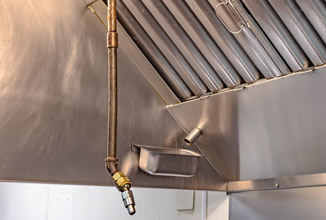-
Contact
Sales & Customer Service
0800 612 6537 support@safelincs.co.uk Live ChatDelivery Enquiries
0800 077 6149 - Resources
Fire & Safety Solutions
CALL OUR TEAM NOW 0800 612 6537
Lines open today 8:30am - 5pm
Free Delivery
on 100s of Products
Secure Payments
with our fast checkout
Live Customer Chat
Available Now
30 Day Accounts
for Public Sector
5 Star Customer Feedback
Ansul Kitchen Suppression Servicing and Maintenance
What is an Ansul Kitchen Fire Suppression System?

Generally suited to locations where deep fat fryers, griddles, broilers and other cooking equipment is found, an Ansul or Kitchen Fire Suppression System utilises a wet chemical suppressant to extinguish and control a fire. Most often found in restaurants, kitchens, and other commercial cooking environments, this type of suppression system utilises a number of important steps to stop the spread of fire.
A kitchen fire suppression system is firstly designed to automatically shut of the gas line if a fire, or excessive heat, is detected (this kills the fuel source to the fire). Due to the high operating temperatures in a kitchen environment when cooking with oils and grease, many kitchen fires can continue to burn and spread even after the gas has been shut off. A kitchen suppression system, following the gas shut off, then utilises a series of nozzles aimed at the areas of high fire risk, which when activated, will discharge a wet chemical fire suppressant. This suppressant has been developed specifically to combat and suppress grease fires, and prevent them from re-igniting. During this process, the kitchen hood will activate to help remove smoke from your kitchen.
What is typically included in a Servicing and Maintenance Package?
Certain elements should be included in all servicing and maintenance packages for kitchen fire suppression systems. These elements are in place to give you the confidence that your system has been serviced properly, by someone who is qualified, and that it has been completed to a recognised industry standard.
- Visit by a certified suppression engineer
- A complete inspection of your suppression system and all associated components
- Confidence that your suppression system will operate correctly
- All servicing and maintenance works carried out in accordance with UL300 Standard or alternative recognised industry standard
- Comprehensive report and diagnosis of any issues that may require remedial work
What usually happens during the servicing and maintenance on an Ansul Suppression System?
During the site visit, a trained engineer will carry out a thorough check of the system to ensure that it is fit for purpose and will operate correctly in an emergency situation. These regular checks are also critical to the longevity of the system, ensuring that all components are free from wear or damage. You can expect the following to take place during a site visit:
- Check actuation line connection, and check for any leaks in actuation line
- Check gas valve operation
- Check regulated release for operation
- Check tank contents and assembly
- Inspect blow off caps and nozzles, and check all nozzles are correct for the equipment they are protecting
- Apply silicone grease across nozzle orifice, and check all nozzles and pipework are free of cooking grease
- Note any changes to kitchen equipment layout and note if any equipment is not protected
- Manually test the regulated release assembly by operating the remote manual pull station
- Check pull station for wear and tear, and test electric actuation switches
- Replace all fusible links with new
- Inspect detection line for operation and wear and tear - checking wire tension
- Inspect and check each firing cartridge is full and not defective
- At least annually, use dry air or nitrogen and blow through the agent distribution piping with the nozzle blow-off caps removed, verifying that dry air or nitrogen is discharging at each nozzle location
- At least annually, replace all rubber blow off caps
- Reinstate system upon completion of service, and record test and service date on equipment
- Complete service and test certificate, noting any remedial actions where required
What questions will I be asked before servicing and maintenance can take place?
- How many tanks does the Ansul / kitchen suppression system have?
- Are there any known faults or issues?
- Are you able to provide an image of the existing system?
- Has the system been maintained before?
- Can maintenance be completed during normal working hours? (cooking system must have cooled down prior to a visit)
- Are there any access restrictions or requirement for permits to work?
- Are you able to provide the last maintenance certificate for review? (if applicable)
Reviewed: 22/12/2022 (doc:758 V1.0). Our articles are reviewed regularly. However, any changes made to standards or legislation following the review date will not have been considered. Please note that we provide abridged, easy-to-understand guidance. To make detailed decisions about your fire safety provisions, you might require further advice or need to consult the full standards and legislation.



























